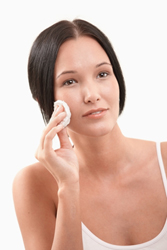The Ayurvedic Skincare Routine for Facial Skin
Clear, healthy, lustrous skin can be yours at any age if you spend just a few minutes taking care of it everyday. A skincare routine should ideally start in the pre-teen years and be followed regularly for the best results. Also, a healthy balanced diet and an efficient digest-absorb-assimilate cycle inside your body are crucial for vital, healthy skin.
Three Simple Twice-a-Day Steps
Ten minutes is all it takes each morning and evening to care for facial skin.
Cleansing:
Cleansing not only removes surface grime, make-up and impurities, it also stimulates your skin and preps it for topical nourishment. For the face and neck, it’s a must-do each morning and night. Choose a non-soap cleanser appropriate for your skin type, or a tridoshic formulation balanced to work on all skin types.
If you have dry Vata skin (space or air predominant skin), choose a rich, nourishing cleanser that won’t strip the natural oils from the skin, with ingredients like oatmeal, almond meal and cream. If you have sensitive fire predominant skin, choose a gentle herbal cleanser that will purify without irritating the skin.
Sandalwood in fine oatmeal with a little cooling milk and rose water makes a gentle Pitta-pacifying cleanser. For oily earth or water predominant skin, a stimulating product that contains oil-balancing herbs such as lavender, lemon, neem and tulsi helps cleanse and clarify.
Prepare your cleanser if you are starting with a dry mix. Then splash your face with lukewarm water to open the pores. Never use hot water on your skin; it will cause your skin to literally wilt. Using your fingertips or a soft washcloth, gently apply the cleanser to your face and neck in smooth upward strokes. The skin surface should get stimulated without being pulled or stretched. Rinse off with warm water, and finish with a final splash of cool water. If you wear make-up, two cleansing of the face at night may be appropriate to make sure all of it is cleansed off.
Toning:
Toning is an important step in the daily skincare routine because it removes any lingering impurities or greasy residue and helps balance the pH of the skin. It closes the pores and stimulates circulation, helping to prepare the skin to absorb nutrition from the moisturizer that follows. Choose a toner appropriate for your skin type, and look for toners without alcohol, colors or artificial fragrance. Rose, sandalwood and cucumber would be good choices for Vata, Pitta and Kapha skin respectively.
If your toner is a spritzer, close your eyes and gently mist on face and neck. Dab any excess gently with a ball of cotton. Alternatively, apply the toner to the face and neck with a ball of cotton, using smooth, gentle upward strokes.
Moisturizing:
All types of skin need a moisturizer. Moisturizers seal in surface moisture and help keep skin soft and supple. If enriched with skin-friendly herbs and essential oils, moisturizers also nourish the skin and enhance skin immunity. Natural Ayurvedic moisturizers contain herbal extracts and essential oils in an oil base-richer oils for dry skin and light oils for oily skin. Gotu kola, Shatavari, Turmeric, Sandalwood, Brahmi, Amalaki, Tulsi and Neem are examples of nourishing, ojas-building herbs that are considered skin rasayanas in Ayurveda.
Apply moisturizer immediately after the toner, while your skin is still slightly damp. If using a facial oil, all you need are 3-4 drops. Gently massage the moisturizer into facial skin with smooth upward strokes. For extra-dry areas, use a little additional moisturizer.
Additional care, once or twice a week.
Exfoliation once a week for Kapha skin and once every other week for Vata and Pitta skin adds that extra glow.
Facial Mask:
All types of skin benefit from periodic deep-down exfoliating treatment; if you have really oily skin, you may want to exfoliate at least once a week. At its most basic, a facial mask is a little oatmeal or chickpea flour mixed with water and a touch of honey. You can add almond meal, rosewater and a couple of drops of wheat germ oil for dry skin, almond meal and pure aloe vera juice for sensitive skin and Bentonite clay, lemon peel and tulsi or neem powder for oily skin. You can also enrich the mask with pure essential oils suitable for your skin type. Exfoliation removes dead skin cells, embedded dirt and toxins, and stimulates the skin, making it receptive to the nutrient-rich facial moisturizer that should follow.
Wash your face with lukewarm water. Apply the mask with smooth upward strokes with your fingertips or a ball of cotton. Wait a few minutes in a relaxed position while the mask dries. Rinse off with plenty of warm water and follow with a moisturizer appropriate for your skin type.
Note: This Ayurvedic information is educational, and is not intended to replace standard medical care or advice.
The Author:
Shreelata Suresh is a yoga instructor from the Bay Area. She writes on Ayurveda and yoga for various publications.
